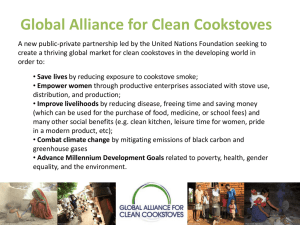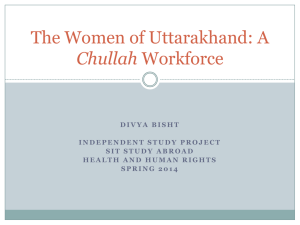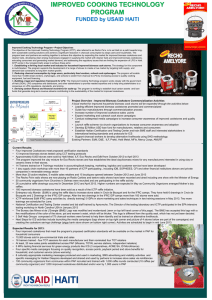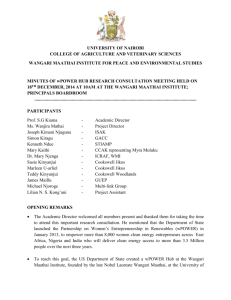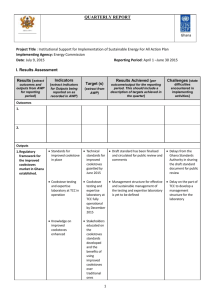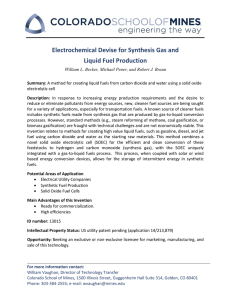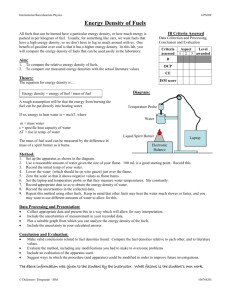Meeting the Needs of Women through Clean Cooking Solutions Corinne Hart
advertisement
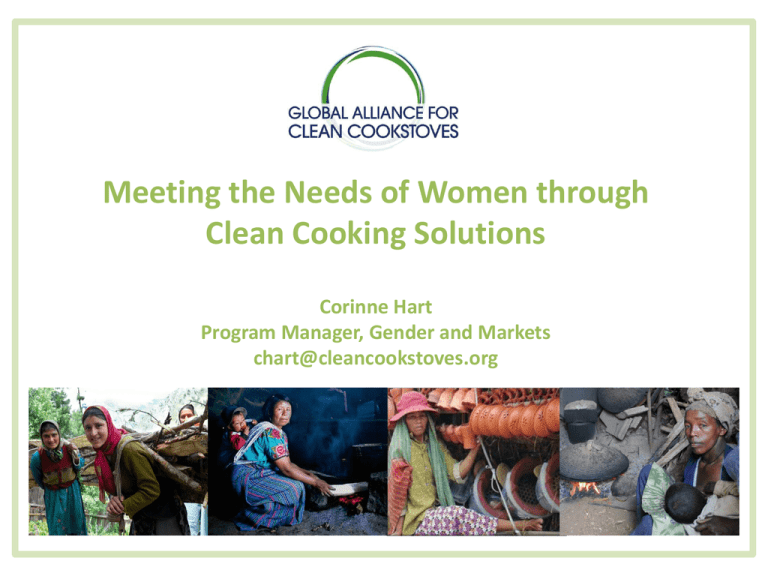
Meeting the Needs of Women through Clean Cooking Solutions Corinne Hart Program Manager, Gender and Markets chart@cleancookstoves.org The Problem 3 billion people dependent on traditional stoves 2 billion tons of biomass burned each year Exposure to air pollution typically up to 100 times more than recommended as healthy by WHO 2 million people die annually – one of the top 4 health risks Up to 30% of household income spent on fuel Up to 4 hours a day spent on collecting fuel Women and children disproportionally impacted Lack of Access to Energy is a Gender Issue • Women face inequities that limit their access to energy services. o 70% of those who live on less than a dollar a day are women, 75% of the world’s 876 million illiterate adults are women, and women only own 1% of the world’s property. o Difficult to access credit, own businesses or property, access trainings, and afford and purchase technologies. • The lack of access to energy can exacerbate existing inequalities. o Male-owned enterprises that are able to access modern energy services have a huge advantage over women-owned businesses that have a harder time accessing new technologies, training, and forms of energy. • As natural resources deplete, women have to undertake increasingly labor-intensive activities, such as walking further distances or using more toxic fuels, such as dung or trash. This increased labor is almost always unpaid and uncounted as formal labor. • In humanitarian settings and conflict zones, women face an increased vulnerability to gender-based violence while out collecting fuel. o In the refugee camps in Sudan, women have to organize themselves to collect 3 firewood together at night to try to reduce their vulnerability to attack. Gender Livelihoods Environment Fact Women can spend up to 4 hours a day collecting wood – or 60 days a year. Households can spend up to 30% of their income on fuel expenditures. Over 20% of black carbon emissions globally comes from cookstoves. Opportunity Cost Costs and Opportunities Between now and 2030, women can spend almost 3 years of their lives in collecting fuel. Between now and 2030, an average Kenyan household will spend 5 years of income on fuel. An additional 100 million people will be cooking with dirty cookstoves in the year 2030 – adding to black carbon emissions. 4 Clean cookstoves are a tangible solution. Going from open fires or traditional cookstoves to cleaner cookstoves and fuels will lead to: Less exposure to toxic smoke Fewer burns and other injuries Less income spent on and time needed to collect fuel More time for education and income-generating activities Reduced greenhouse gas emissions and deforestation saving lives, improving livelihoods, empowering women, and preserving the environment. 3 Innovation and technology have provided the sector with a variety of stoves for different fuels. Advanced Super Clean Stoves Improved Stoves Traditional Stoves More options and technologies in development Constant Quality Improvement 6 We do have a foundation to build on… • At least 2 million stoves sold last year but the market today remains fragmented… No ‘one-sizefits-all’ solution Many actors often working in their own silos • Decades of cookstove implementation experience • Hundreds of active stove organizations Thousands of manufacturers of different sizes and capacities Highly Fragmented Mixed sector track record in actual adoption Variety of fuels along the energy ladder Positive directional indicators, but solid evidence yet to be built 7 with multiple barriers for each stakeholder. Distributors and Retailers Lack working capital and struggle to identify economically-viable models for distributing stoves and delivering after-sales services to remote rural customers. Designers and Manufacturers Researchers Donors Lack adequate capital for R&D and facilities. Limited market intelligence on needs, size of market, etc. Tariffs and taxes prohibitive in some circumstances. Lack of coordination amongst cookstove researchers. Disconnected with donors interested in cookstove issues. Lack of full awareness of the magnitude of the issue, ‘time is right’ changes in the sector, and tangible means of addressing the issue, and of developing evidence base in support of issue. No globally recognized cookstove standards Consumers Lack awareness about risks of traditional stoves and availability and benefits of clean cookstoves. Many stoves do not meet local cooking needs. 8 Women have a key role to play. Women play a critical role to play in the development of these emerging markets – from the design of technology, to innovative distribution, awareness raising and spurring adoption, women must be involved in every aspect of the value chain. Women and girls use 90 percent of their income in ways that benefit their families and communities. Additional income controlled by women from fuel savings or generated from cookstove businesses could have a huge impact on their families. Women have livelihood opportunities throughout the value chain, from designing and marketing to selling and maintaining clean cookstoves. In related industries, women involved throughout in the value chain have more than doubled their family's income. 9 Women have a key role to play. Women can increase awareness of the negative impacts and solutions through unique methods of marketing and communications, such as womento-women marketing, Where women are already managing household energy, they can provide key leadership and insight to ensure that solutions meet their needs and incorporate local knowledge and innovation. Existing innovative distribution chains that involve women’s cooperatives can reach consumers who may not be easily reached through other distribution mechanisms. 10 The Global Alliance for Clean Cookstoves The Global Alliance for Clean Cookstoves was launched by Secretary Clinton and is an innovative public-private partnership to create a thriving global market for clean and efficient cookstoves and fuels. Photo Credit: Sunil Lal Photo Credit: E+Co Photo Credit: GTZ Photo Credit: Nigel Bruce The Global Alliance for Clean Cookstoves Vision • Universal adoption of clean and efficient cookstoves and fuels. Mission • Save lives, improve livelihoods, empower women, and combat climate change by creating a thriving global market for clean and efficient cookstoves and fuels. Goal • 100 million households adopt clean and efficient cookstoves and fuels by 2020. 12 390+ Partners and Growing Donor Countries Canada Denmark Finland Germany Italy Ireland Malta Netherlands Norway Spain Sweden United Kingdom United States Private Sector Donors NGO and MFI National Partners Afghanistan Bangladesh Burkina Faso Cambodia China Colombia El Salvador Ethiopia Ghana Guatemala Kenya Laos Lesotho Malawi Mexico Nepal Nigeria Rwanda South Africa Tanzania Peru Viet Nam Uganda Central American Integration System The Alliance convened the sector to develop a cohesive strategy to ignite change. More than 350 practitioners and other experts 11 expert Working Groups 6 months of engagement Strategy report released in November 2011! 14 A three-pronged strategy has been developed to spur the clean cookstove market. • Understand and motivate the user as a customer • Reach/ensure adoption at the last mile • Finance the purchase of clean cookstoves and fuels • Develop better cookstove technologies and a broader menu Enhance of options Demand Strengthen Supply • Finance clean cookstoves and fuels at scale • Access carbon finance • Build an inclusive value chain for clean cookstoves and fuels • Gather better market intelligence • Ensure access for vulnerable populations (humanitarian) Foster an Enabling Environment • Promote international standards and rigorous testing protocols, locally and globally • Champion the sector to build awareness • Further document the evidence base (health, climate, and gender) • Engage national and local stakeholders • Develop credible monitoring and evaluation systems 15 Alliance Global Value Propositions Alliance will play a catalytic role in our efforts to reach 100m adoption goal by the year 2020. Catalyze the Sector and Broker Partnerships Promote International Standards Mobilize Resources Champion the IssuePhase3 2018-20 End Enable Markets Coordinate Sector Knowledge and Research Key Message for Phase 3 Critical Research Well Underway Along with Tools to Catalyze Action and Build Momentum Filling in the evidence gaps … • Child Survival RFA released in April ~ $1m with match now provided by NIH • Climate Mapping RFP to be released end of May ~ $500k • Gender and Livelihood Research released in Sept ~ $250k • Testing Center RFA released early July ~ $1.3m • Innovative Business Models ~ $1m in July/August • Capacity building and working capital fund RFA to be launched in October ~ $3m Developing online communities of practice … …and Biennial Clean Cookstove Conference in Cambodia next 17 Spring Potential Target Countries, Phase I. Focus Countries Active Countries Partner Countries Alliance Role Potential Target Countries for Phase 1** Transformative; likely to require engagement of 5+ years; multiple intervention strategies and actions East Africa region (Kenya, Uganda, Tanzania, Rwanda), Ethiopia, Bangladesh, Vietnam Targeted intervention; likely 1- 3 years of engagement; extrapolation of learnings applicable to other partners Indonesia, Ghana, Nigeria, Guatemala, Mexico, Peru Sharing of knowledge and practices; country tool kits; brokering partnerships among stakeholders **Countries to be finalized after all stakeholder consultation meetings. All other partner countries 18 Two Track Approach to Enabling Markets General Sector Support: - Mobilize Resources - Champion Sector - Knowledge Hub - Catalyze sector and broker partnerships - M+E - Strengthen Evidence Base Standards and Testing Engage Government Capacity Development Consumer Research Technology and Manufacturing Entrepreneur Training Reaching the Last-Mile Access to Finance (all types) Market Intelligence (Open Source) Activities for the public good that benefit the entire sector Innovation Tailored support that focuses limited resources on driving scale 19 Gender mainstreaming in the Alliance and throughout sector activities Gender Fully Integrated into the Fabric of the Alliance Build Sector Expertise and Fill Data Gaps Build Capacity of Partners to Mainstream Gender and Empower Women Gender-informed M&E Gender Focal Point Assessment and Implementation Toolkits Established Methodology Research Expert Gender Committees 20
